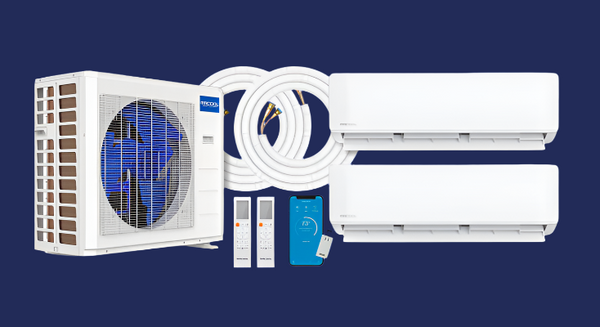Common MRCOOL DIY Air Conditioning Installation Problems and How to Solve Them
Installing a MRCOOL DIY air conditioning system is a fantastic way to save on installation costs and enjoy the satisfaction of completing a major home improvement project. However, like any DIY project, the process comes with its own set of challenges.
At MRCOOL DIY Direct, we’re committed to ensuring that our customers have a smooth installation experience. Below are some common installation problems that DIYers encounter, along with tips and solutions to help you get your system up and running efficiently.
1. Incorrect Measurements
Problem:
One of the most frequent issues is incorrect measurements for the line set lengths, especially with multi-zone systems. If your measurements are off, you may end up with lines that are either too long or too short, which could affect your installation and performance.
Solution:
Measure twice, install once. Make sure you have accurate measurements of the areas where you plan to place the indoor and outdoor units before ordering your system. Keep in mind that DIY Pre-Charged lines cannot be cut to length, so it’s essential to choose the appropriate length from the wide range available. Always refer to the installation manual for recommended clearances and placement.
For multi-zone systems, use our FREE multi-zone system configurator to determine the right line set lengths for each zone.
2. Improper Mounting of the Indoor Unit
Problem:
If the indoor unit is not mounted properly, it can cause noise, vibration, or improper operation. Uneven or insecure mounting is a common issue during DIY installations.
Solution:
Use the provided mounting template to ensure precise placement for the hole locations and anchor points. Install the mounting bracket securely, ensuring it is level and firmly attached to the wall. Double-check that all screws and bolts are tightened and that the unit is securely mounted before proceeding with the rest of the installation.
3. Refrigerant Leaks
Problem:
Refrigerant leaks can occur if connections are not properly secured or if the lines are damaged during installation. Leaks can lead to system inefficiency and potential damage.
Solution:
Handle the refrigerant lines carefully and follow the installation instructions closely. Ensure that all connections are tight and secure. After installation, check for leaks using a leak detection solution or a refrigerant leak detector. Preventing leaks during installation is crucial to the system's performance.
4. Electrical Connection Issues
Problem:
Incorrect electrical connections can lead to system failure, intermittent problems, or even pose safety hazards such as electrical shorts or fire risks.
Solution:
Make sure the power supply matches the system requirements. Follow the wiring diagram in the installation manual carefully. If you are unfamiliar or uncomfortable with electrical work, it is highly recommended to hire a licensed electrician to assist with this part of the installation to avoid any mistakes.
5. Inadequate Insulation of Refrigerant Lines
Problem:
Poorly insulated refrigerant lines can reduce the system’s efficiency and cause issues like noise and condensation buildup.
Solution:
Wrap the refrigerant lines thoroughly using the insulation provided with your MRCOOL DIY kit. Ensure there are no gaps or exposed areas that could lead to condensation or a reduction in system efficiency. Proper insulation is key to maintaining performance and preventing future issues.
6. Improper Condensate Drainage
Problem:
If the condensate drain is not installed correctly, it can cause water leaks and potential damage to your home.
Solution:
Ensure that the condensate drain is properly connected and has a slight downward slope to allow for effective drainage. Check for any kinks or obstructions in the drain line, as these could lead to water backing up in the unit.
7. Not Following the Installation Manual
Problem:
Many installation issues arise when steps in the installation manual are skipped or not followed closely. This can lead to operational inefficiencies and future problems.
Solution:
Take your time to read the installation manual thoroughly before starting. Follow each step carefully, and don’t hesitate to refer back to the manual if something doesn’t seem right. If in doubt, always err on the side of caution and reach out for help.
Additional Tips for a Smooth Installation
Control Wiring
For MRCOOL DIY Series systems, ensure that the control wiring matches the numbers, not the colors. The numbers are printed on the connectors, and while they may be hard to see, it is critical that they are matched correctly by zone.
Pre-Charged Line Sets
Be sure to check the pre-charged line sets for dust caps, which may have fallen off during shipping. Ensure there is no debris or contaminants before connecting the couplers to avoid damaging the system.
Refrigerant Valves
Don’t forget to open the refrigerant valves when prompted in the installation guide. For multi-zone systems, you may have a king valve in addition to the line set valve, and both need to be opened as instructed.
Electrical Connections
Double-check that your electric connections from the breaker box to the condenser are secure. Also, ensure that the AC disconnect switch is properly connected and tightened.
Conclusion
Installing a MRCOOL DIY air conditioning system is designed to be a straightforward process, but attention to detail is critical for a successful installation. By being aware of common install problems and following these tips, you can avoid headaches and ensure your system works efficiently from day one.
If you ever run into an issue you can’t resolve, don’t hesitate to reach out to MRCOOL DIY Direct for support. We’re here to help every step of the way. Enjoy your new MRCOOL system and the comfort it brings to your home!




